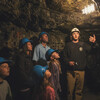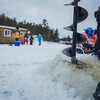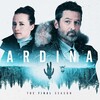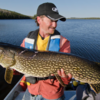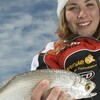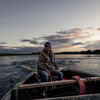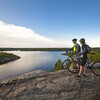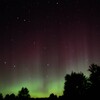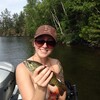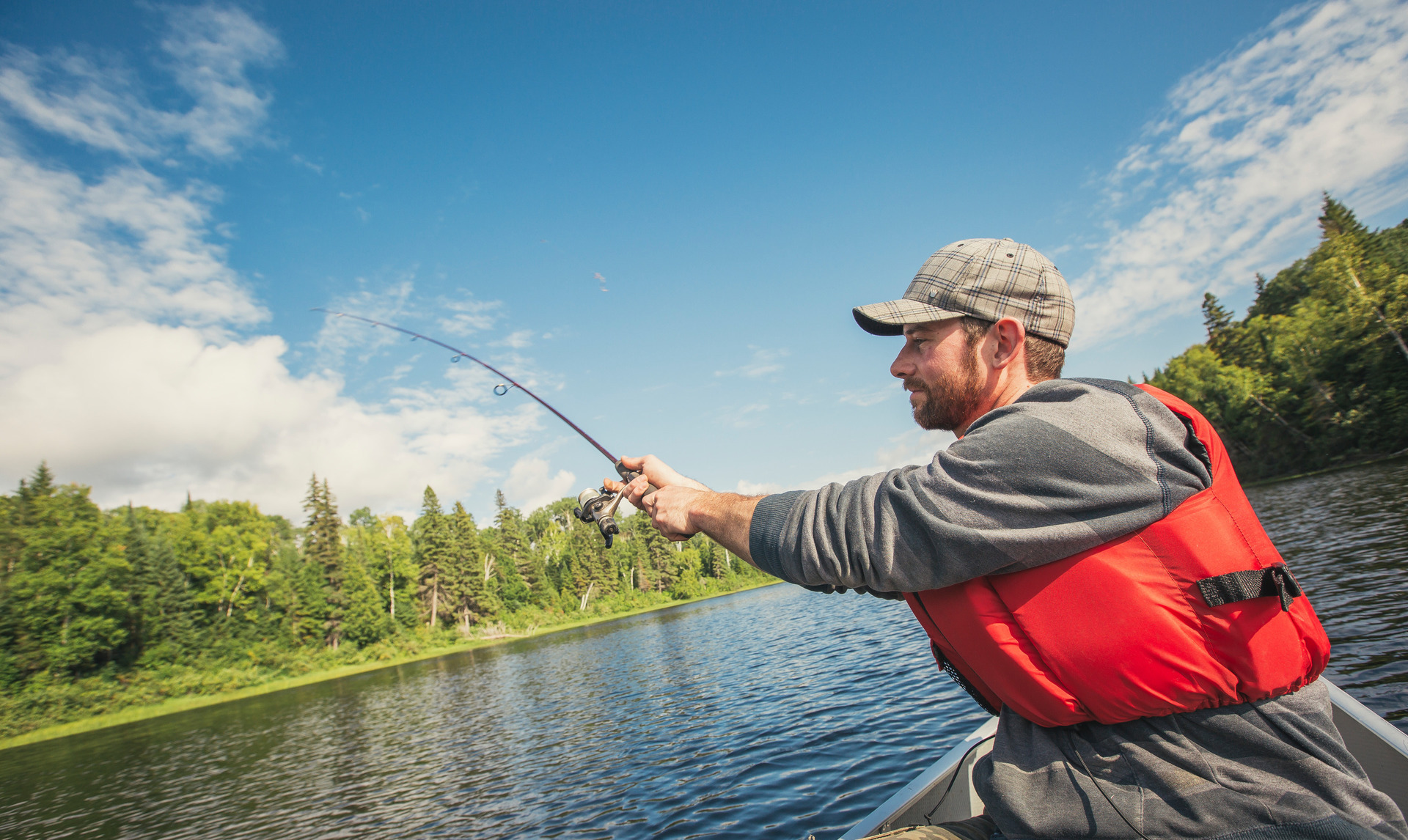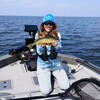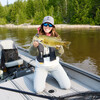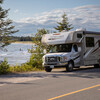Big Fishing in Northeastern Ontario
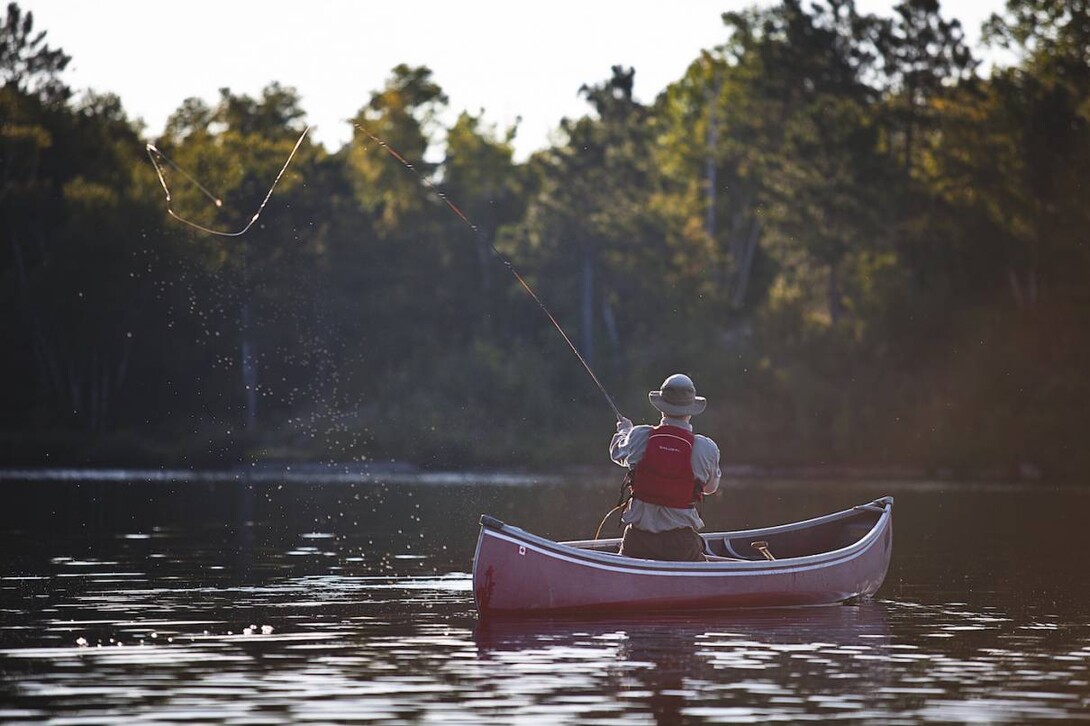
If you’ve always wanted to land that monster pike or whopping walleye, Northeastern Ontario has the BIG fish for your BIG fishing dreams. Here’s what you need to know about the species most commonly found in the region:
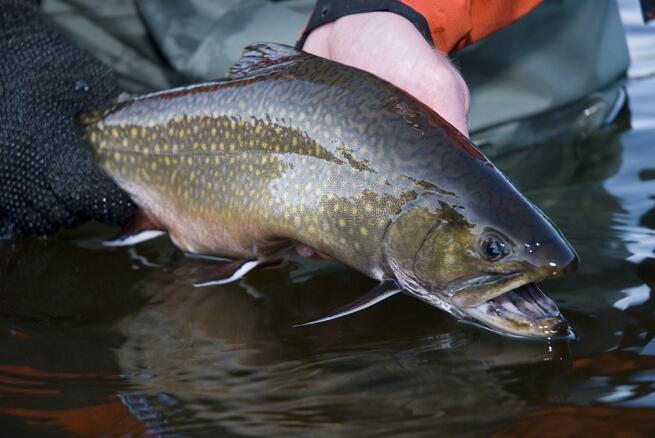
Brook Trout
The brook trout, or speckled trout, is part of the salmon family. They are dark olive-green on the back, with lighter sides that feature pale spots and smaller red dots surrounded by blue halos, a white belly and reddish fins. Although it’s called a trout, the brook trout is actually a char. In small streams, it reaches an average length of 20-30 cm (roughly 8 to 12 in) and a weight of 1 to 3 lb in inland lakes.
Habitat: The brook trout inhabits large and small lakes, rivers, streams, creeks, and spring ponds. They prefer cool, clear pure water with a narrow pH range.
Fishing: A popular catch-and-release game fish, brook trout are most active around shorelines in the spring and fall, so be sure to fish near overhanging trees, submerged wood, and rocky points and shoals. As the waters warm up, brook trout move into deeper waters and become harder to find, so it’s best to use a boat or canoe if you’re fly-fishing.
A hook, worm, and split-shot combination are a simple and effective way to catch brook trout, but minnows, leeches, and insects, as well as small to mid-sized spoons, worm-tipped spinners, minnow-imitating crankbaits, small jigs, jerk baits, and artificial flies are also good baits.
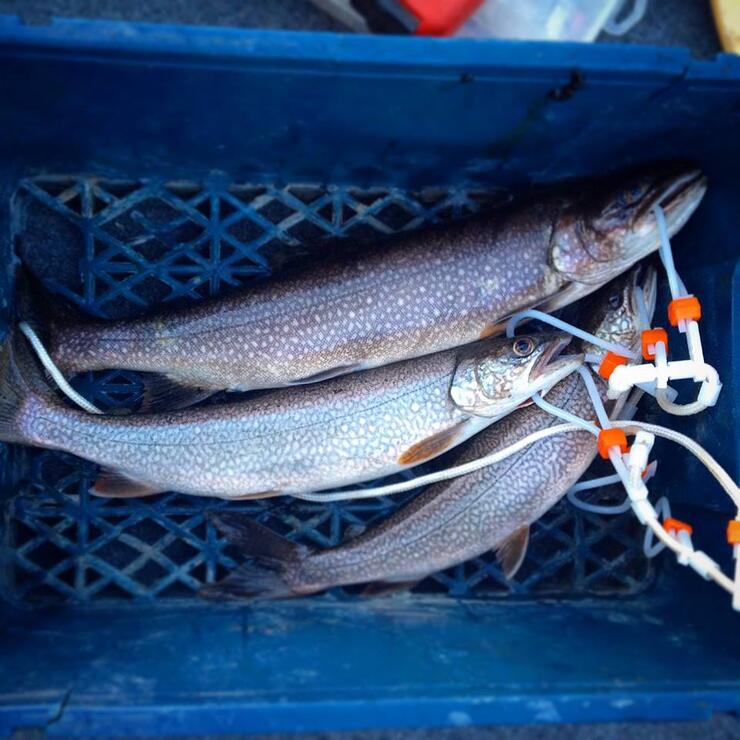
Lake Trout
Lake trout is a freshwater char with an average size of 2-10 lbs. Its body is slate grey to greenish in colour, with a lighter underside. Cream- to yellow-coloured spots are generally seen on the head, body and dorsal and caudal fins. The lower fins tend to be orange-red with a narrow white edge.
Habitat: Lake trout inhabit cold, deep and oxygen-rich bodies of water.
Fishing: The lake trout is prized as a game fish and popular for its taste. Deep-water trolling is the best way to catch lake trout, but spin- or fly-fishing is also common. Lures to use include spinners, spoons, plugs, streamers and wet flies, and large minnows as live bait.
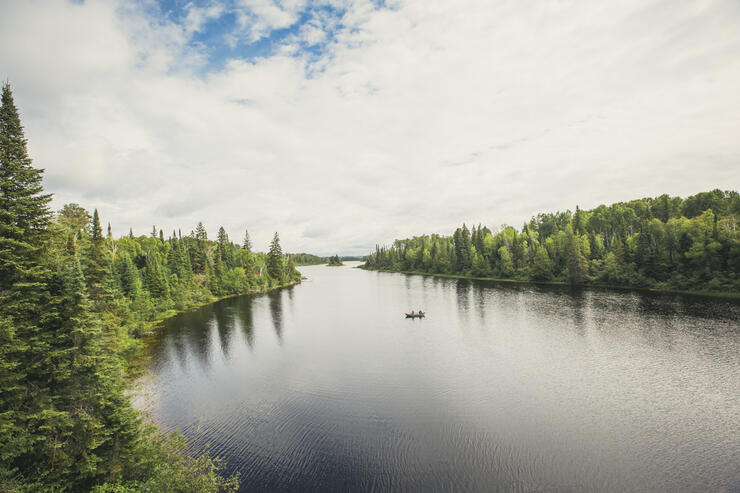
Rainbow Trout
The adult rainbow trout weighs an average of 1 to 5 lb, and are generally blue-green or olive-green with heavy black spotting over the length of the body with a broad reddish stripe along the lateral line from gills to tail. This is most noticeable in breeding males.
Habitat: Rainbow trout inhabit moderately deep, cool lakes and small to moderately large, well-oxygenated shallow rivers with gravel bottoms.
Fishing: Rainbow trout are a sought-after game fish, popular with fly fishers. Some consider the rainbow to be the hardest-fighting trout species because it is known for putting up a powerful struggle, leaping high into the air when hooked. Its meat is tender with a mild, nutty flavour, and can be cooked as soon as it’s cleaned, without scaling, skinning or filleting.

Muskellunge
Muskellunge, or “muskie,” is a large, relatively uncommon freshwater fish. It is the largest member of the pike family, reaching an average weight of 10 to 20 lb and 70 to 120 cm in length (roughly 28 to 48 in). Although it’s rare, some muskies have been known to reach 182 cm (roughly 6 ft) and 70 lb.
The fish are a light silver in colour, with a brown or green overlay, and dark vertical stripes on the flank, which may break up in spots, or not appear at all. Its large mouth has several long, needle-like teeth. Muskies closely resemble the northern pike in both appearance and behavior. They are ambush predators with an elongated body and flat head, and the dorsal, pelvic and anal fins are set far back on the body. However, the lobes of the tail fin in muskellunge come to a sharper point, while a pike’s are generally more rounded, and unlike pike, muskies have no scales on the lower half of their opercula.
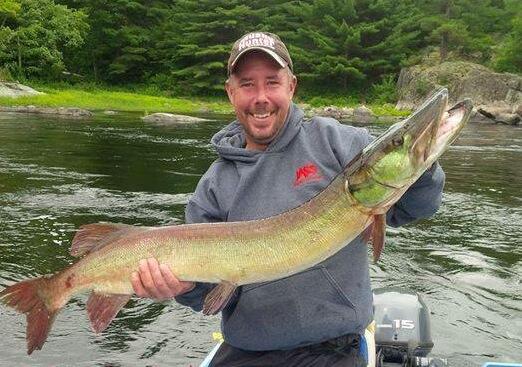
50 1/4" muskie on the French River - Photo provided by Crane's Lochaven
Habitat: Muskellunge prefer cooler, clear waters where they can lurk along the weeds, rock outcrops or other structures.
Fishing: Muskies are prized as great sport and trophy fish, but anglers are encouraged to practise catch-and-release because their populations are low. The best time to fish the monster muskie is after the season opens in June, and in September when the waters start to cool.
These powerful predators can swim fast in short spurts. They are known for their strength and their tendency to leap from the water in stunning acrobatic displays, as well as their use of headshaking in an attempt to rid itself of a hook. Large surface or diving lures, spoons, and buck tail spinners are effective, as well as live bait such as suckers, chubs, and frogs.
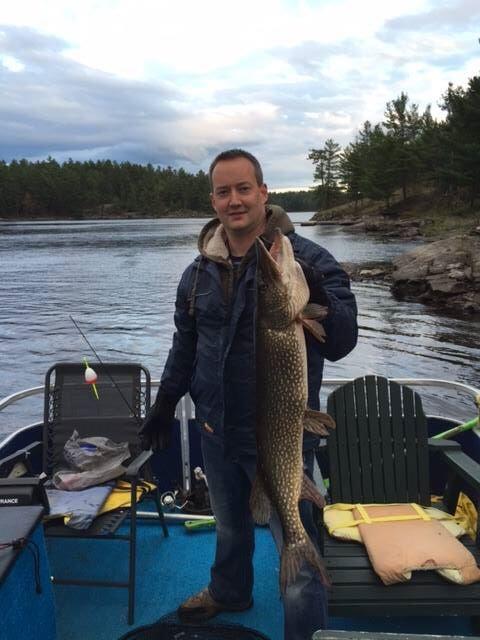
This 37" pike was caught on the French River - Photo provided by Crane's Lochaven
Northern Pike
The northern pike, or simply pike, is olive-green with shading from yellow to white along its belly. The flank is marked with short, light bar-like spots, with dark spots on the fins. The average size is between four and 10 lb. A pike more than 20 lb is considered quite the trophy!
The pike is an aggressive, carnivorous species, and a typical ambush predator. They will lie in wait for prey, and then strike with a sudden high-energy burst of unsteady swimming to capture it.
Habitat: Pike are typically found in sluggish streams and shallow, weedy places in lakes, as well as in cold, clear, rocky waters. During the summer, they tend to group near vegetation and will stay closer to shore on sunny days, while heading farther out on windy days.
Fishing: With their aggressive hits, aerial acrobatics, and determined fighting, fishing for pike can be very exciting. Spring, early summer, and fall are the beat times for trophy fishing. When summer is at its peak, use the deep-water trolling technique because pike will head to deeper water where there are submerged weed beds or other kinds of cover. Fly-fishing is another way to catch them along drop-offs, points, and islands. Effective lures include jerk baiting, large spoons, noisy surface or diving lures, and bucktail spinners, as well as shiners, frogs, and large chub for live bait.
Northern pike have a bony flesh, so anglers tend to release their catch. Be very careful when handling a big pike. They are a little slimy, tend to thrash around, and have a nasty set of teeth.
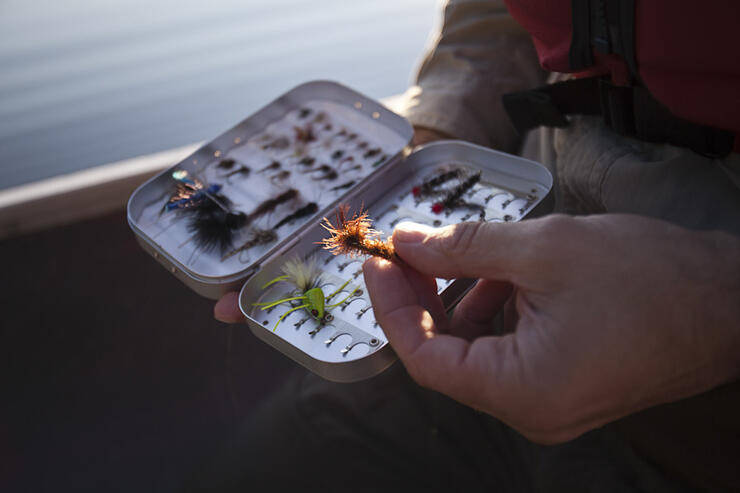
Smallmouth Bass
Known as one of the black basses, the smallmouth bass is a member of the sunfish family. Its average size is around 1 to 3.5 lb. It is generally brown in colour with red eyes and dark brown vertical bands along its sides, and its upper jaw extends to the middle of the eye.
Habitat: The smallmouth is found in deep, cool waters around rocks, sand, or gravel areas of rivers, creeks and lakes. In the winter, they will often migrate to deeper pools and enter a semi-hibernation state, moving sluggishly and feeding very little until the warmer weather returns.
Fishing: A tough fighting fish, the smallmouth bass is highly regarded for its top water fighting ability when hooked. They are most active from late spring to late autumn and can be found in open water or along rocky points, drop-offs, or shoals.
Smallmouth are popular with anglers who use conventional spinning and bait casting gear, as well as fly-fishing tackle. Try curly-tailed jigs, crankbaits, shallow-diving spinnerbaits, in-line spinners, streamer flies, or crayfish imitations.
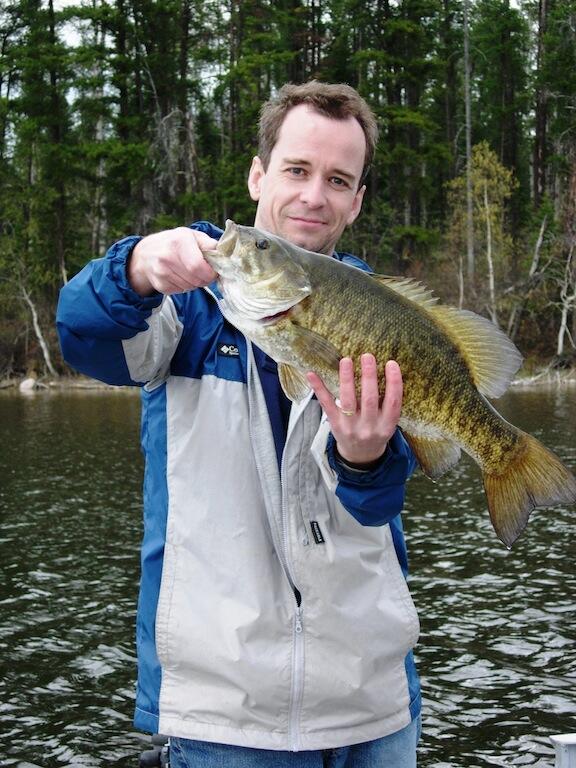
Largemouth Bass
The biggest of the black basses, the largemouth bass is a freshwater game fish in the sunfish family, reaching 1.5 to 4 lb in weight. It is olive-green in colour, and marked by a series of dark, sometimes black, blotches forming a jagged horizontal stripe along each flank. When you look at the back of the fish’s mouth when it is closed, the mouth will extend past the eye. The mouth of the smallmouth bass will not extend that far.
Habitat: Largemouth bass inhabit bodies of water that are shallow and warm, and they typically prefer areas that are rich in aquatic plants, flooded stumps, logs, standing timber, and brush.
Fishing: Keenly sought after by anglers, and respected for the excitement of their fight, largemouth will often become airborne in their effort to throw the hook, although they’re not quite as tough as the smallmouth.
The largemouth are most active from early summer to early autumn, and respond to plastic worms, top-water lures, shallow-running crankbaits, weedless spoons, and buzz- and spinnerbaits. Live bait such as leeches, minnows, and night crawlers are also a good choice.

Yellow Perch
Weighing up to 1 lb, the yellow perch, commonly referred to as “perch,” is a freshwater fish easily recognized by its pale golden yellow colour, dark stripes and its laterally compressed body shape Acclaimed by many as “the ultimate pan fish,” yellow perch is prized for its delicious, mild flavour.
Habitat: Commonly found in both large and small lakes, the yellow perch also inhabits slow-moving rivers and streams, brackish water and ponds. Its summer habitat ranges from weedy areas to rock/sand/rubble shoals to mossy mud flats.
Fishing: Yellow perch are most often found in schools of more than 50 fish arranged by age and size in a spindle shape. Perch are most active during the day and are relatively poor swimmers, unable to accelerate quickly.
Use worms, live and dead minnows, crickets and any small lure resembling these for bait. Try a jig head when fishing over weed beds, and use the spindle-type bobbers for the least resistance when the bait is struck. Raising the rod top usually provides more than enough force to set the hook.
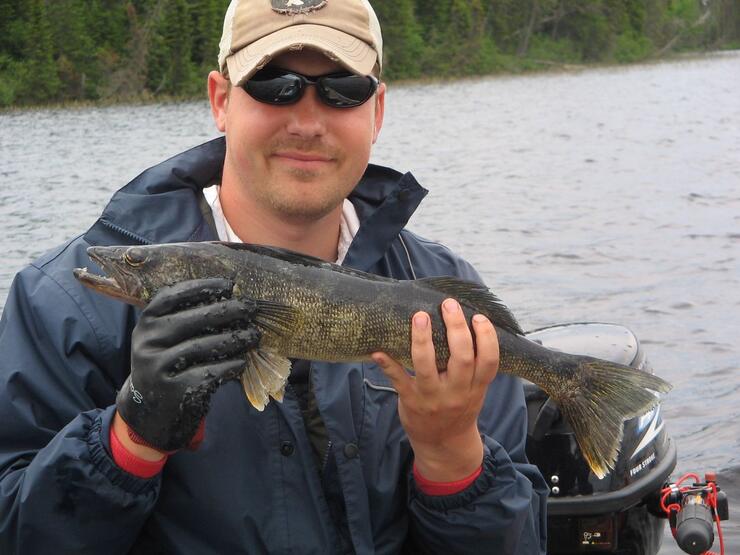

This 30" walleye was caught in the French River - Photo provided by Crane's Lochaven.
Walleye (Pickerel)
These prized game fish average between 1.5 and 3 lb, but it’s not uncommon to catch one that weighs up to 10 lb. Mainly olive-green and gold in colour, the walleye has five darker saddles extending to the upper sides, and shading to white on the belly. The walleye’s large mouth is armed with many sharp teeth.
Habitat: Walleye prefer stained waters on hard, rocky bottoms, but they also inhabit weedbeds in shallow, fertile lakes.
Fishing: Walleye are most active during spring and fall. Because their eyes are adapted to low-light conditions, walleye tend to feed more at dawn and dusk; on cloudy, windy days; and in stained water. However, in darkly stained waters, walleye tend to feed throughout the day.
One of the easiest and most effective tactics is to drift and jig just off the bottom until you find a school of walleye. Some anglers prefer to troll with spinners, spoons, and deep-running crankbaits, while others will use minnows, night crawlers, crayfish, or leeches.

Salmon
Ranging in size from 10 to 30 lb, the Chinook salmon is a greenish colour, fading to silver on the sides and belly, and is defined by the red or purple colour on the back and top of its head, as well as its black gum line. The Chinook’s colouring can appear almost black at spawning time.
The Coho salmon averages 8 lb, but can weigh as much as 35 lb, and can measure more than 60 cm (2 ft) in length. It has a dark metallic blue or greenish back with silver sides and a light belly. Spawning fish in rivers are dark with reddish sides, and develop hooked jaws and teeth. Coho salmon spawn only once and then die.
Habitat: In spring and fall, salmon can be found around shorelines and rivers. Typically, both the Chinook and Coho spawn in large, deep rivers from early September to November. They head toward cooler, deeper water in warmer weather.
Fishing: Anglers can increase their luck by trolling in a zigzag pattern. The lifting and darting motion, along with the lure’s dropping action can really entice the fish. Salmon will take a variety of lures including spoons, streamer flies, wobbling plugs, spinners, and cut-bait holders. Spawn sacs are also effective at river mouths and in rivers.
Recommended Articles
The Seven's Best Hikes, Biking Trails and Lakes

7 Best Spots to Check Out in The Seven

Budget Bliss: Explore Northeastern Ontario Without Breaking the Bank

Bring Your Fam!

Time to Unwind: 6 Spa Havens to Discover In The Seven
5 Amazing Places to SUP in Northeastern Ontario

5 Amazing Bike Rides to Discover

Northern Lights in Northeastern Ontario

Northeastern Ontario's Best Pride Festivals

Fish for one of the World's Rarest Species of Trout

An Insider's Guide to Manitoulin Island

6 Small-Town Gems to Explore in Northeastern Ontario

11 Best Things to Do in Kapuskasing, Ontario



